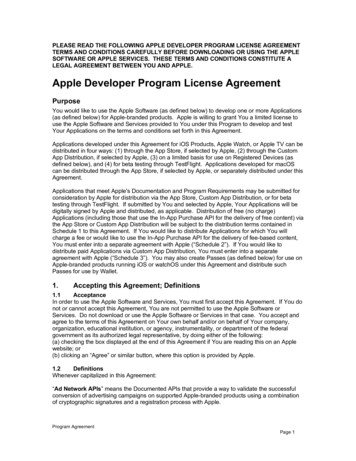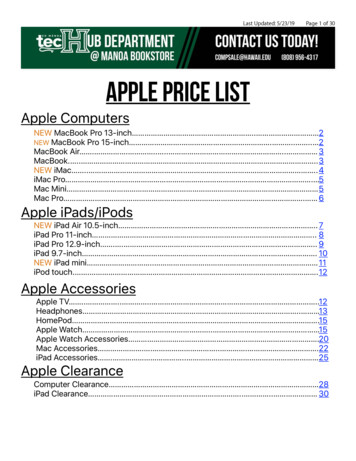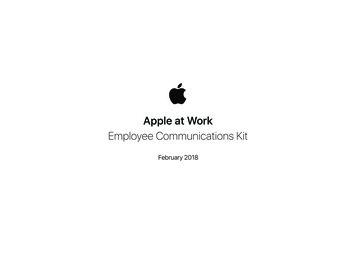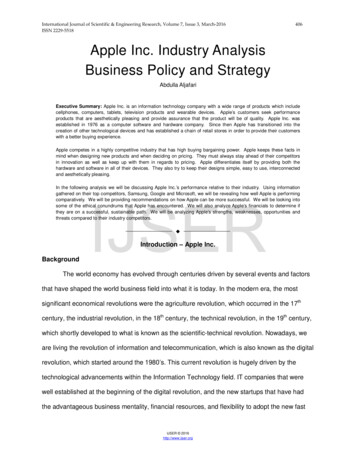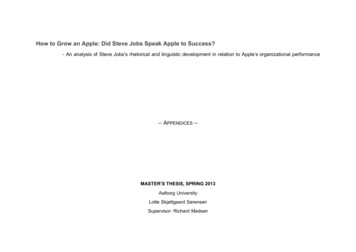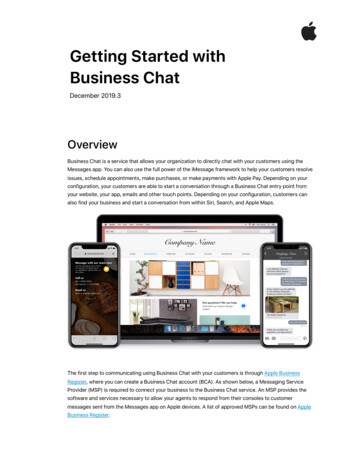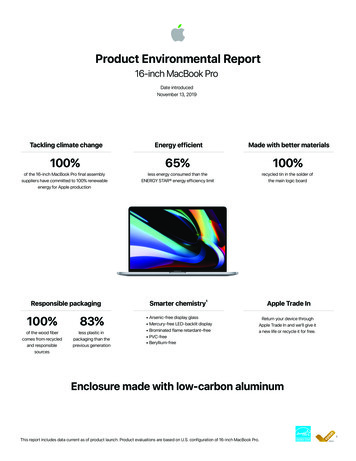
Transcription
Product Environmental Report16-inch MacBook ProDate introducedNovember 13, 2019Tackling climate changeEnergy efficientMade with better materials100%65%100%of the 16-inch MacBook Pro final assemblysuppliers have committed to 100% renewableenergy for Apple productionless energy consumed than theENERGY STAR energy efficiency limitrecycled tin in the solder ofthe main logic boardResponsible packaging100%83%of the wood fibercomes from recycledand responsiblesourcesless plastic inpackaging than theprevious generationSmarter chemistry1 Arsenic-free display glass Mercury-free LED-backlit display Brominated flame retardant–free PVC-free Beryllium-freeApple Trade InReturn your device throughApple Trade In and we’ll give ita new life or recycle it for free.Enclosure made with low-carbon aluminum2This report includes data current as of product launch. Product evaluations are based on U.S. configuration of 16-inch MacBook Pro.
DefinitionsRecycled materials: Recycling makes better useof finite resources by sourcing from recovered ratherthan mined materials. Recycled content claims formaterials used in our products have been verified byan independent third party to a recycled contentstandard that conforms to ISO 14021.Bio-based plastics: Bio-based plastics are madefrom biological sources rather than from fossil-fuelsources. Bio-based plastics allow us to reduce relianceon fossil fuels.Renewable materials: We define bio-materials asthose that can be regenerated in a human lifespan,like paper fibers or sugarcane. Bio-materials canhelp us use fewer finite resources. But even thoughbio-materials have the ability to regrow, they are notalways managed responsibly. Renewable materials area type of bio-material managed in a way that enablescontinuous production without depleting earth’sresources. That’s why we focus on sources thatare certified for their management practices.Supplier Clean Energy Program: Since the electricityused to make our products is the largest contributor toour overall carbon footprint, we’re helping our suppliersbecome more energy efficient and transition to newrenewable energy sources. As part of this program,Apple and our suppliers are working to generate andprocure more than 4 gigawatts of new renewableenergy worldwide by 2020. This goal representsapproximately one-third of our current manufacturingcarbon footprint.EndnotesCarbon footprint: Estimated emissions are calculatedin accordance with guidelines and requirements asspecified by ISO 14040 and ISO 14044. There isinherent uncertainty in modeling carbon emissions dueprimarily to data limitations. For the top componentcontributors to Apple’s carbon emissions, Appleaddresses this uncertainty by developing detailedprocess-based environmental models with Applespecific parameters. For the remaining elements ofApple’s carbon footprint, we rely on industry averagedata and assumptions. Calculation includes emissionsfor the following life cycle phases contributing toGlobal Warming Potential (GWP 100 years) in CO2equivalency factors (CO2e): Production: Includes the extraction, production,and transportation of raw materials, as well as themanufacture, transport, and assembly of all partsand product packaging. Transport: Includes air and sea transportation ofthe finished product and its associated packagingfrom manufacturing site to regional distribution hubs.Transport of products from distribution hubs to endcustomers is modeled using average distancesbased on regional geography. Use: Apple conservatively assumes a four-yearperiod for power use by first owners. Product usescenarios are based on historical customer usedata for similar products. Geographic differencesin the power grid mix have been accounted for ata regional level. End-of-life processing: Includes transportationfrom collection hubs to recycling centers andthe energy used in mechanical separation andshredding of parts. For more information on thecarbon footprint, visit apple.com/environment/answers.1 Appledefines its restrictions on harmful substances, including definitions for what Apple considers to be “free of,” inthe Apple Regulated Substances Specification. Every Apple product is free of PVC and phthalates with the exceptionof AC power cords in India, Thailand, and South Korea, where we continue to seek government approval for ourPVC and phthalates replacement. Apple products comply with the European Union Directive 2011/65/EU and itsamendments, including exemptions for the use of lead such as high-temperature solder. Apple is working to phaseout the use of these exempted substances where technically possible.2 The16-inch MacBook Pro achieved a Gold rating for EPEAT in the United States and Canada. Electronic ProductEnvironmental Assessment Tool (EPEAT) is a program that ranks computers and displays based on environmentalattributes in accordance with IEEE 1680.1-2018. For more information, visit www.epeat.net.3 Greenhousegas emissions were calculated using a life cycle assessment methodology in accordance with ISO14040 and 14044 standards and based on the 16-inch MacBook Pro 512GB storage configuration. We often updateour carbon models to leverage new information. As a result, our estimate for the carbon footprint of the previousgeneration—MacBook Pro (15-inch, 2019) standard configuration with 512GB SSD—increased from 354 kg CO2e(as published in its Product Environmental Report) to 385 kg CO2e.Carbon footprint16-inch MacBook Pro15-inch MacBook Pro—816-inch MacBook Pro2.6GHz 6-Core Processor, 512GB Storage394 kg CO2e2.3GHz 8-Core Processor, 1TB Storage465 kg CO2e2.6GHz 6-Core Processor, 256GB Storage352 kg CO2e2.3GHz 8-Core Processor, 512GB Storage385 kg CO2e—Product Environmental Report
Endnotes4 MacBookPro (15-inch, 2019) standard configuration with 512GB SSD was used for comparison as the mostrecently released and similar device, though the display size changed between the two products.5 Enclosuregreenhouse gas emission reduction is based on a comparison to average primary aluminum ingot.6 Third-partyassessments seek to confirm sourcing practices and are part of our responsible sourcing program.In addition, our efforts consider conflict, human rights, and other risks.7 Finalassembly supplier sites for 16-inch MacBook Pro are third-party certified as Zero Waste by UL LLC(UL 2799 Standard). This means these final assembly supplier sites do not generate any waste sent to landfill.8 Onlychemicals that meet GreenScreen benchmark 3 or 4 are considered safer and preferred for use. Finalassembly sites for 16-inch MacBook Pro are among the 18 final assembly supplier facilities that have adopted thesesafer cleaners. GreenScreen is a comprehensive hazard assessment tool that evaluates substances against 18different criteria. For more information, visit www.greenscreenchemicals.org.9 Responsiblesourcing of wood fiber is defined in Apple’s Sustainable Fiber Specification. We consider wood fibersto include bamboo.10 Formore information about our work to protect and create responsibly managed forests, please read ourEnvironmental Responsibility Report.11 Breakdownof U.S. retail packaging by weight.12 Energyconsumption and efficiency values are based on the ENERGY STAR Program Requirements for Computers,including the max energy allowance for the 16-inch MacBook Pro. For more information, visit www.energystar.gov.ENERGY STAR and the ENERGY STAR mark are registered trademarks owned by the U.S. Environmental ProtectionAgency.The 16-inch MacBook Pro is tested with a fully charged battery and powered by the 96W USB-C Power Adapterwith the USB-C Charge Cable (2m). Off: Lowest power mode of the system. System is shut down. Sleep: Low power state that is entered automatically after 10 minutes of inactivity (default), or by selecting Sleepfrom the Apple menu. Wake for network access enabled. Idle—Display on: System is on and has completed loading macOS. Display brightness was set as defined byENERGY STAR Program Requirements for Computers, and Auto-Brightness was turned off. Connected to Wi-Fi. Power adapter, no-load: Condition in which the 96W USB-C Power Adapter with the USB-C Charge Cable (2m) isconnected to AC power, but not connected to the system. Power adapter efficiency: Average of the 96W USB-C Power Adapter with the USB-C Charge Cable (2m)measured efficiency when tested at 100 percent, 75 percent, 50 percent, and 25 percent of the power adapter’srated output current.Power consumption for 16-inch MacBook 0W0.59WIdle—Display on5.22W5.44W5.61WPower adapter, no-load0.09W0.08W0.10WPower adapter efficiency91.7%91.9%92.0%13 Trade-invalues vary based on the condition, year, and configuration of your trade-in device, and may also varybetween online and in-store trade-in. You must be at least 18 years old. In-store trade-in requires presentation of avalid, government-issued photo ID (local law may require saving this information). Additional terms from Apple orApple’s trade-in partners may apply. 2019 Apple Inc. All rights reserved. Apple, the Apple logo, iPad, iPhone, Mac, MacBook, MacBook Pro, and macOSare trademarks of Apple Inc., registered in the U.S. and other countries. Apple Store is a service mark of Apple Inc.,registered in the U.S. and other countries. ENERGY STAR and the ENERGY STAR mark are registered trademarksowned by the U.S. Environmental Protection Agency. Other product and company names mentioned herein may betrademarks of their respective companies.916-inch MacBook ProProduct Environmental Report
12 Energy consumption and efficiency values are based on the ENERGY STAR Program Requirements for Computers, including the max energy allowance for the 16-inch MacBook Pro. For more information, visit www.energystar.gov. ENERGY STAR and the ENERGY STAR mark are registered trademarks owned by the U.S. Environmental Protection Agency.
